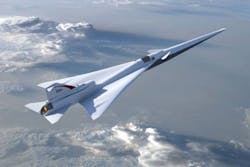NASA and Lockheed to begin X-59 supersonic jet tests in 2021
WASHINGTON - Despite the use of advanced design tools, the team developing NASA’s X-59 Quiet Supersonic Technology (QueSST) demonstrator cannot be sure it will meet their “low-boom” goals until the jet actually breaks the sound barrier in flight. Although design features that reduce sonic booms are understood, the team faces the challenge of ensuring that the X-59 QueSST retains its unique boom-softening shape while in flight. It is also unclear how sound from the jet will move through the atmosphere, writes Jon Hemmerdinger for FlightGlobal.com. Continue reading original article.
The Intelligent Aerospace take:
June 9, 2020 -The X-59 is shaped to reduce the loudness of a sonic boom reaching the ground to that of a gentle thump, if it is heard at all. It will be flown above select U.S. communities to generate data from sensors and people on the ground in order to gauge public perception. That data will help regulators establish new rules to enable commercial supersonic air travel over land.
Construction of the X-59, under a $247.5 million cost-plus-incentive-fee contract, is continuing at Lockheed Martin Aeronautics Company’s Skunk Works factory in Palmdale, California.
Related: NASA's experimental X-59 supersonic jet could be built by the end of 2020
Related: NASA's supersonic 'X-plane' ready to be built
Related: Collins to provide avionics for NASA's supersonic X-59
Jamie Whitney, Associate Editor
Intelligent Aerospace
